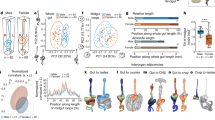Abstract
IN the course of investigations on the phosphorus metabolism of the wax moth, Galleria mellonella, it was found that there is as much as 2–4 per cent phosphorus in the excreta of the larvæ, of which only a small proportion is inorganic orthophosphate. The greater part, 60–70 per cent, is a labile phosphorus compound which is converted almost entirely to orthophosphate following 7 minutes hydrolysis at 100° C. in 1 N hydrochloric acid. As analysis of the honeycomb showed that it contained only orthophosphate, we had ground for supposing that the readily hydrolysable phosphorus in the excreta is formed in the larval body1.
This is a preview of subscription content, access via your institution
Access options
Subscribe to this journal
Receive 51 print issues and online access
$199.00 per year
only $3.90 per issue
Buy this article
- Purchase on Springer Link
- Instant access to full article PDF
Prices may be subject to local taxes which are calculated during checkout
Similar content being viewed by others
References
Niemierko, S., and Niemierko, W., Abstr. of Communications, 1st Internat. Congress of Biochemistry, 620 (1949).
Mann, T., Biochem. J., 38, 345 (1944).
Wiame, J. M., J. Amer. Chem. Soc., 69, 3146 (1947).
Wiame, J. M., J. Biol. Chem., 178, 919 (1949).
Author information
Authors and Affiliations
Rights and permissions
About this article
Cite this article
NIEMIERKO, S., NIEMIERKO, W. Metaphosphate in the Excreta of the Wax Moth, Galleria mellonella. Nature 166, 268–269 (1950). https://doi.org/10.1038/166268a0
Issue Date:
DOI: https://doi.org/10.1038/166268a0
This article is cited by
Comments
By submitting a comment you agree to abide by our Terms and Community Guidelines. If you find something abusive or that does not comply with our terms or guidelines please flag it as inappropriate.



